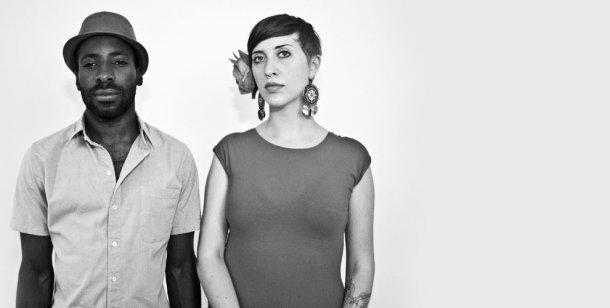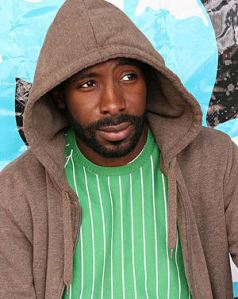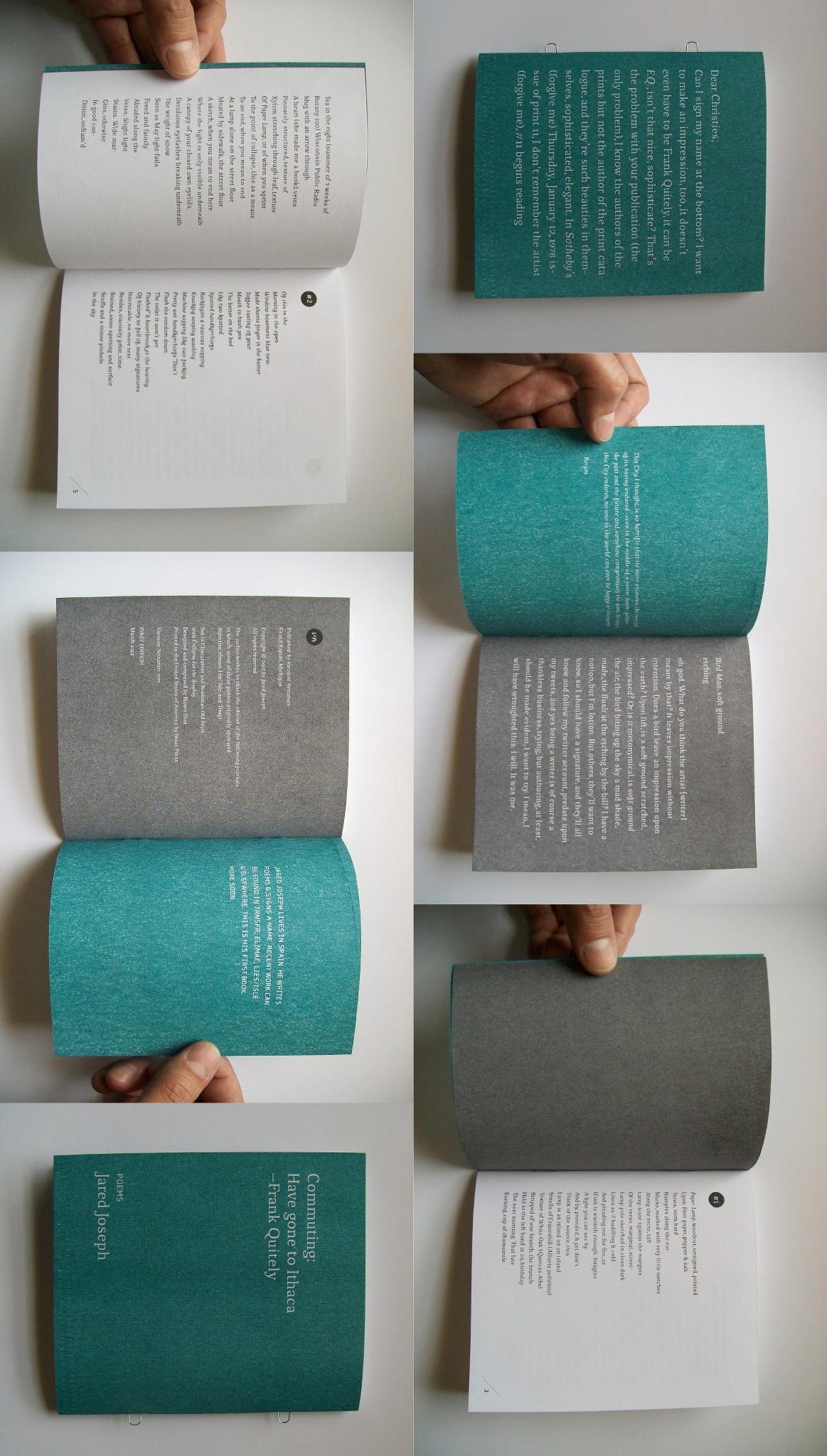Tishon is a designer, writer and poet who has read his work at Bowery Poetry Club, LouderARTS Reading Series, La Mama and other venues in New York and New Jersey. In August 2011, Tishon founded Well&Often. He is also a founding member of BBOXradio.com. Tishon lives in Brooklyn.
Together, Caits and Tishon are the authors of The Letter All Your Friends Have Written You, and the founders of Well&Often Press.
***
Used Furniture Review: The Letter All Your Friends Have Written You is such an interesting book because it’s co-authored. Both of you have an equal share of writing in it. Why did you decide to write a book of poetry together?
Tishon: Caits and I met shortly after I graduated Pratt Institute, where we both studied Graphic Design. Upon becoming friends we found we had a shared passion in writing. About four years into our friendship, we were looking to work on some kind of project together. We were both, at the time, thinking about releasing a chapbook and we thought maybe we could do a collaboration. Once we started looking at the work together, we found our poems had a surprising rhythm and many shared themes across our very different backgrounds. The whole thing just felt right and good, so we went for it.
UFR: The title poem of your collection is written by Caits. Here, the second stanza: “Put your finger on each joy: butter melts on bread/ phantom warmth of subway seat/ roll of tongue over teeth/ defined peek of collarbone in summertime/ There are always children.” No doubt, this kind of warmth carries through the whole collection. Literature in general, I think, is a vehicle for the communication of sadness, loneliness, alienation, etc. What draws you to the lighter side of things rather than the darker?
Caits: This is a wonderful observation to receive! Truthfully, I spent many years in recent past grappling with my demons. In some ways those demons were very real, alive creatures creating havoc in my life, and I leaned into them as a means of self discovery. During this time I wrote a poem to my favorite poet, Yusef Komunyakaa, calling out for the experience of darkness in order to write “like him.” Magically, the call was answered and I fell into a deeply transformative time of pain: the breakdown of a dear relationship, the splitting from a job that caused an unsettling depression. A month after these two drastic changes, I received an email with the good news that I’d won a writing contest that resulted in a trip to the Pan-African Literary Conference in Ghana to study under Yusef. It was uncanny, and terrifically life affirming.
In the past few years I’ve done a lot of reflection on this concept of the mad, brilliant artist that tells us we need to be essentially mentally ill to become great at our craft. I refuse to believe that honoring and cultivating darkness is an experience necessary to my contributions as a writer.
The world is overwhelming in it’s darkness, injustice and pain. I consciously took a vow to focus on being an instrument of light. Even what I consider my most serious work has been called “pretty,” a word I resented at first, but have come to feel great affection for. Life does not come wrapped up in a bow, and we certainly need to explore all shades of light and lack of light in art. However, we need not become slaves of darkness.
UFR: At the same time, though, you do enter into that creative space where you can allow life’s sadness to come through. In “How Mavis Staples Healed My Heart,” for example, you write, “She grins. Takes my hand in hers,/ and sings my favorite song, I know a place, ain’t nobody cryin’…” A question, then: What do you draw upon when you’re writing? Experience? Emotions? What do you feel the most?
Caits: For me, love has been the driving, motivating force in my work. It is what I notice in my students as well. Love is their go-to-topic in their first stages of writing. Everyone wants to talk about love lost and found, and for good reason. What else gives life such magnificent taste and texture and feeling?
Sadness, as you mention, is a beautiful emotion and experience at it’s core, and one that I struggle through in my writing a great deal. It appears to conceal its beauty at times, but it’s always there, sneaking under the surface. It serves so many important purposes in life: self awareness, empathy and the growth towards becoming a whole individual. “Mavis” is my favorite poem of mine in the collection. It’s a conversation between a singer and myself, two sides of my consciousness, a therapy session of sorts. I write Mavis Staples in to tell me my loneliness is okay, that I will be okay. I needed her to tell me that, and she did. Her message remains. I often find myself needing to tell myself it will all be okay in my work.
UFR: A simple, yet big question: Why do you write?
Caits: I asked my high school students this last week to open our session. They all stammered and hemmed and hawed:
“Because I have to get these feelings out. Because I have things to say. Because I feel too much. I don’t know, I just do.”
I ended the dialogue with my own commentary, “I asked you this question because I still don’t know how to answer it myself. I just do. I just have to.”
I think it’s truly as simple as that.
Tishon: For me, it’s a way of remembering to notice things. My writing is often meditations on the stuff I deal with every day. Also, because it’s fun. I like words and pushing them around and making them do what I want. There’s a whole weird power thing happening. A lot of writers probably won’t admit to being into it but they are.
UFR: What does your revision process look like?
Caits: Usually, writing comes to me in an uncensored frenzy (often at a most inconvenient time) and then I immediately read back to clean up what begs a bit of trimming and rearranging. I then enlist the help of friends like Tishon and my mentor, the acclaimed poet Roger Mitchell, for their guidance and perspective, and return to the work with this new insight to shape more.
I find subtracting to be most helpful as I can be long winded. A friend of mine, poet James Caroline, emailed me a response to a poem years ago in which he suggested I read each line over. If it didn’t hold up on it’s own, take it away. It isn’t an easy task, but it’s worth it when it clicks.
Tishon: My poems are perfect when I write them. The last time I tried to edit a poem, it exploded. It’s a liability.
UFR: Who are some of your creative influences? Why?
Tishon: William Carlos Williams because he’s from New Jersey and his work taught me how to notice and write about it in as few words as possible. Mark Twain is my hero because of his propensity for joke-telling, even when the subject matter is anything but funny. Jeffrey McDaniel is a favorite for the same reason. Marty McConnell, Staceyann Chin, Ralph Ellison, Langston Hughes, Jay-Z…
Caits: I am drawn to artists and musicians who shape shift, who don’t follow rules on creating and refuse to limit themselves. In my early life, I loved Gil Scott-Heron and Ani Difranco. Both taught me that poetry can come in varying spaces: spoken word, written word, song, visual art, story. I still find that my musical explorations are often described as a combination of the two, a compliment I gladly receive. Black women poets like Sonia Sanchez, Nikki Giovanni, Audre Lorde and Lucille Clifton were also instrumental to my development as a woman-identified writer. They all proved strength and beauty in spaces that refused them, they forced the world to see them. I find young women are now the population most drawn to my work, and it is no wonder. I feel honored to continue that legacy in my own way.
Recently, I have been interested in the works of poets who really dig into life with their use of language. Ocean Vuong, Elana Bell, Patrick Rosal, Marty McConnell, Tina Chang, Yona Harvey, Aracelis Girmay.
UFR: The book is split into many sections. Examples include “One by One the Goldfish Died,” “You Deserve Better than a T-shirt,” “It’s A Sick World, Miss Caitlin,” “Lay Beside Me Like You Used To,” and “I Silently Thank the First Girl You Kissed.” These sections serve as kinds of chapters, with several poems tucked into each. Why did you organize the book this way? Is it based on chronology or something else?
Caits: Each header was pulled from a poem in the chapter. The book vaguely chronicles a coming of age story, two stories, really, and where they intersect and compliment each other.
“One by One the Goldfish Died,” is the chapter on childhood. The fantasy play and the hard realities learned through discovery.
“You Deserve Better than a T-shirt,” is about high school, adolescence, about finding your place. The title is from Tishon’s tribute to a childhood friend lost to violence. In the poem, the line takes on a different weight. It refers to his feeling that his deceased friend deserved a grander, more personal memorial than a t-shirt with an RIP that neighbors wear for a week and then put into the bottom of a drawer.
“It’s A Sick World, Miss Caitlin,” is political and social work, discovery of the world beyond the self, and where one fits into it. The line, found in the poem “Gio”, is something a student shared with me. He was right, it sure is. But, as I want to remind him in the poem, it is beautiful, too.
“Lay Beside Me Like You Used To,” and “I Silently Thank the First Girl You Kissed.” Both chapters on love found and lost, crucial to growth and unavoidable in our journeys.
The book ends on a singular poem by Tishon called “Inbound,” forever my favorite. It expresses a great hope, a true poetic tribute to those very small moments that make life worth it through all the stretching and pain it takes to arrive… well, anywhere.
UFR: Notably, this book also marks the inception of your press, Well&Often. Why did you decide to helm a press of your own?
Tishon: It was Virginia Woolf. When I found out that much of her work was published by her own press, Hogarth, I thought to myself, “Why not?” If you have the means to do it, and you’re naive enough to think your writing is worth a damn, do it. I don’t need to tell you that right now is probably the easiest time in history to get into publishing. The internet has made a lot of things far more accessible and the nature of the business is shifting. Much like the music business, there are a lot of independent artists who are out there working hard, trying to find their way and creating great work while doing so. There’s no money in it but there’s fulfillment.
UFR: As a press, and also as authors, what’s been your biggest obstacle?
Tishon: We’re still new, so I think we have a lot of obstacles ahead but so far the toughest thing has been reconciling vision with the realities of budget. Luckily, as a designer, I deal with that on a daily basis so it’s getting easier to manage. Also, because we’re small we can take our time with things until they’re just right.
UFR: What’s your press currently up to? Any more projects on the way?
Tishon: We’re currently taking submissions for an anthology of poems and prose written by educators. Our goal is to publish one or two titles a year, so the anthology is our main project for 2012. We’re also excited about The Well&Often Reader, a section of our site where we’ll be publishing writing centered around the concerns of today. You can email submissions@wellandoftenpress.com for more information.
UFR: How exactly, did this book come into being, anyways? I don’t necessarily mean in a creative way, but more in a technical way. From cover to cover it’s really quite beautifully designed. What was the process of putting together your own collection like?
Tishon: From inception, I had an idea of how I wanted the book to look. I’m drawn to classic design, the work of typographers like John Baskerville and William Caslon, so I’d spent a lot of time looking at at their type specimens. At the same time, I wanted to use a contemporary typeface, so I ended up setting the book in Epic, a great typeface designed by Neil Summerour. I also came across some old books from the 70s at a Herb Lubalin show at Cooper Union, one of which was color ink printed on color paper. That’s where that idea came from. Oh, I also came across an early TS Eliot book at an exhibition at Poets House that was beautifully printed. My thinking was that, if fifty years from now, someone can pick up this book and think it beautiful, then it’s a successful design. As far as the act of putting it together, that’s boring and best done with a lot of beer on hand. Also, research printers. A good printing company is your best friend.
UFR: What are you currently working on? As writers, where do you want to go in the future?
Caits: I am currently working on the aforementioned publications with Well&Often. In my own writing, poems keep coming, as always. I am also working on shaping a few personal essays and short fiction pieces. Scary territory for me, all the newness that comes with the stretch of medium. I also teach part time in New York City public high schools. Some of my best collaborative experiences have come out of this space.
Tishon: On top of Well&Often, I work full time at an interpretive museum design firm, so that requires a good bit of my creative energy but writing keeps me sane. I’m working on a novel about party clowns. It’s very serious.
UFR: Finally, keeping in step with your book’s title, how important are your friends?
Caits: Oh, they are everything. Here is a funny story… Tishon originally hated the title, which at the time, was just the title of the poem. He didn’t “get” it. I tried to explain that the title expressed the sentiments in the poem– it was all the advice my friends gave me when I was breaking up with a great love. All advice mirrored each other, hence, it was the same letter written by all my friends. How many of do this over and over? We seek the same advice in order to really believe it.
Down the line Tishon didn’t only come around to the title of the poem, he wanted to use it for the book’s name. We felt all of our poems were, essentially, letters. To ourselves, to our friends, from our friends, to the world. And as for me, friends have defined my entire personality. How could I not credit them? I am a tribal gal.
Tishon: *Looks at Caitlin* Can’t believe she put that out there. Caits is right, though. You can do almost anything by yourself. Writers especially are a solitary bunch, but sometimes it’s just more fun to do something with people you like.






They are both an inspiration. Loved this so much.